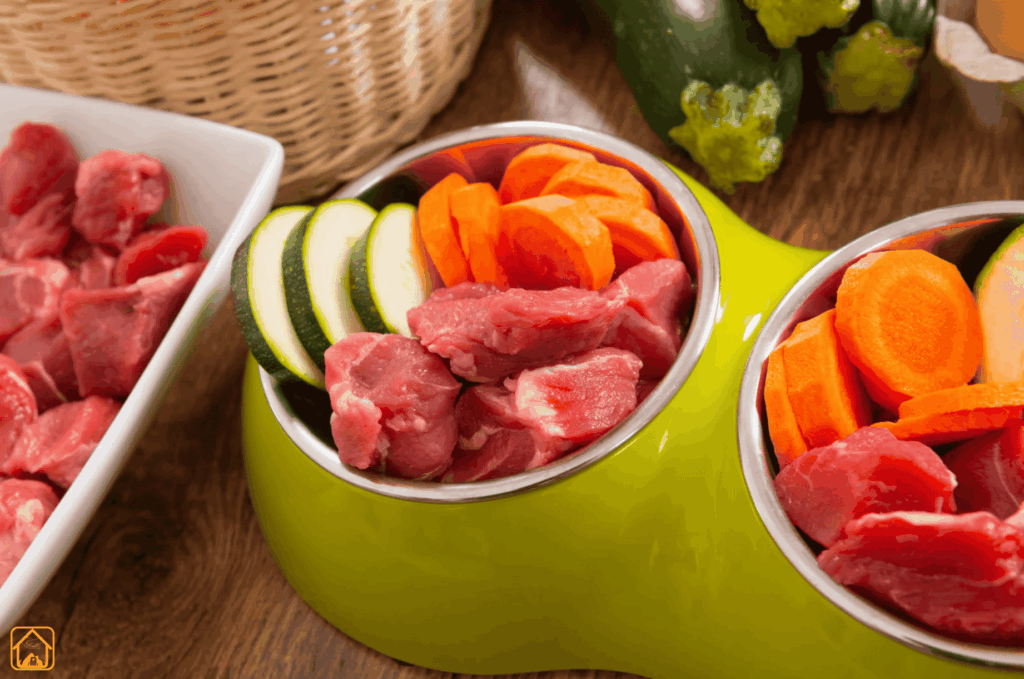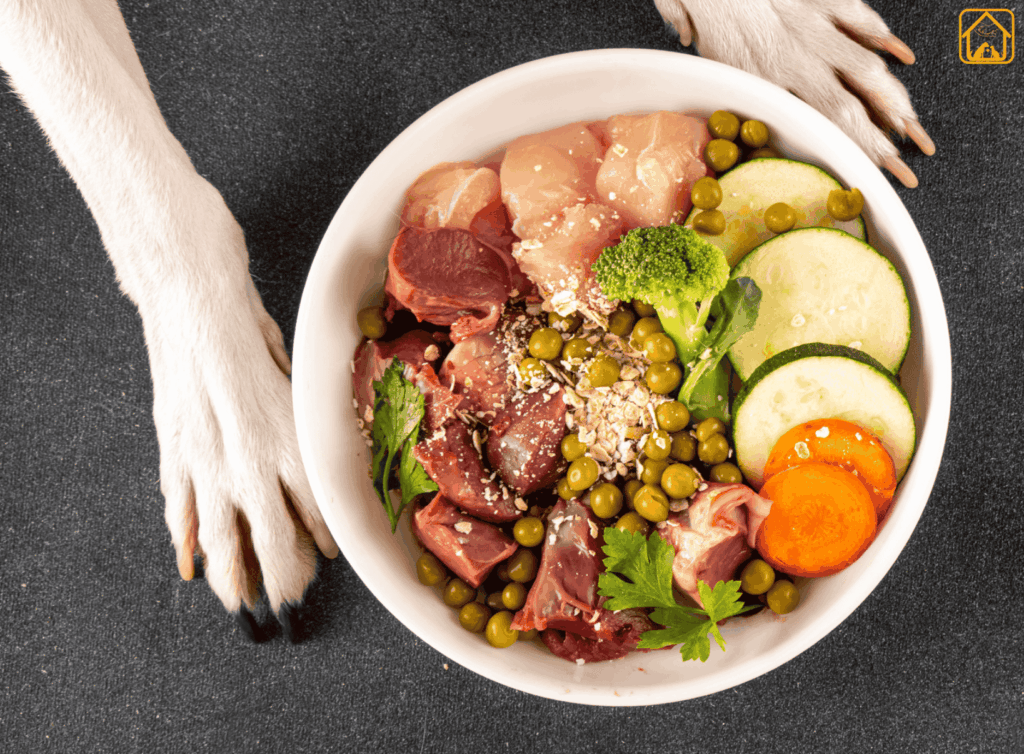More people choose homemade dog food to avoid store-bought options with fillers or unknown ingredients. Whether your dog has allergies or you just want to feed them better, cooking at home can be a healthy and thoughtful choice if done the right way.
Why Consider Homemade Dog Food? (Benefits & Drawbacks)
Let’s be honest, making meals for your dog feels personal. You know exactly what goes into every bite. That peace of mind is priceless, especially if you’ve ever worried about pet food recalls, mystery ingredients, or your dog’s sensitive stomach.
- Control Over Ingredients: You pick the protein, veggies, and grains. No more wondering what “by-products” really are.
- Customizable Nutrition: Homemade dog food lets you support weight management, allergies, or even picky appetites. You can find recipes for homemade puppy food, senior blends, or meals for dogs with sensitive tummies.
- Freshness: Meals made at home skip the heavy processing of commercial foods. Many owners believe their dogs get more flavor and nutrients from real, cooked dog food.
- Bonding: Preparing food for your dog is a labor of love. You might even notice your dog watching you cook, tail wagging, hoping for a taste test.
But there are some drawbacks like
- Nutrition Gaps: Without the right balance, home food for dogs might miss key nutrients.
- Time & Cost: Prepping healthy homemade dog food takes effort and can cost more than kibble.
- Recipe Errors: Swapping ingredients or skipping supplements can cause deficiencies or health issues.
Ever heard a friend say, “I just give my dog chicken and rice”? Feels simple, but it’s not enough for long-term health. Studies, like those from UC Davis, found most homemade dog food recipes, even some from vets, miss the mark on key nutrients. That’s why vet-approved homemade dog food recipes are gold. And why it’s smart to consult a veterinary nutritionist if you want to go this route.
So, is homemade dog food right for you and your pup? If you’re ready to do your homework, measure ingredients, and stick to balanced recipes, it can be a healthy, rewarding choice. But if you need quick, no-fuss meals or you don’t want to buy supplements, it might not be the best fit.
Understanding Dog Nutrition: Essential Nutrients in Homemade Diets
If you’re going to cook for your dog, you’ve got to think like a nutritionist. Dogs aren’t just small, furry people; their diet needs are unique. A healthy dog diet, homemade or store-bought, must include the right balance of six key nutrients:
- Protein: The backbone of your dog’s muscles, immune system, and overall energy. Think chicken, beef, fish, or eggs. Puppies, seniors, and active breeds might need different amounts. (Ever tried to out-snack a Labrador puppy? Good luck!)
- Fat: Not the enemy! Healthy fats provide energy, support skin and coat, and help absorb vitamins. Sources include animal fats and certain oils (like fish or flaxseed oil).
- Carbohydrates: While not strictly “essential,” carbs like rice, oats, or sweet potatoes offer fiber and energy. Some dogs thrive on moderate carbs, others do better with low-carb diets. Know your dog.
- Vitamins: From vitamin A (for vision) to B vitamins (for energy) and vitamin D (for bone health), these are vital. Homemade dog food often falls short here without careful supplementation.
- Minerals: Calcium, phosphorus, zinc, iron, and more, these keep bones strong, blood healthy, and nerves firing. Getting the homemade dog food ratio right is tricky; too much or too little can cause real harm. For example, puppies need more calcium than adults, but too much can mess up growing bones.
- Water: The unsung hero. Fresh water should always be available, especially with cooked meals for dogs that may be lower in moisture than canned food.
To understand this balance better, check out our Dog Nutrition Guide for simple tips on what your dog really needs to stay healthy.
The worst part is, even if you follow a perfect recipe, a small change, like swapping chicken for beef, can throw off the nutrient balance. That’s why experts say, don’t wing it. Use nutritionally complete homemade dog food recipes, ideally ones that are vet approved.
And don’t forget supplements. Most dogs on home prepared dog food need added calcium, vitamins, or fish oil. Skipping these can lead to problems like brittle bones, weak muscles, or skin issues.
I once met a golden retriever whose home diet lacked zinc; her coat was dull and she had low energy. A simple supplement turned things around, but it took a vet to spot the problem.
| Nutrient | Main Sources | Why It Matters |
| Protein | Chicken, beef, eggs, fish | Muscles, immune health |
| Fat | Animal fat, oils | Energy, skin, coat |
| Carbohydrates | Rice, sweet potato, oats | Energy, digestion |
| Vitamins | Supplements, veggies | Metabolism, vision, health |
| Minerals | Supplements, eggshell, bone meal | Bones, nerves, immune |
Homemade dog food can be healthy, but only if they’re complete. Use trusted recipes, measure with care, and check with your vet regularly. Your dog depends on you for every nutrient, every day.
Choosing Ingredients: Safe, Nutritious, and Toxic Foods to Avoid
Picking what goes into your dog’s bowl is both fun and serious. The best homemade dog food starts with safe, high-quality ingredients, just like you’d want for your own meals. But some common foods can be downright dangerous for dogs, so knowing what’s safe (and what’s not) is essential.
- Best Proteins: Chicken, turkey, lean beef, lamb, fish (cooked, boneless), eggs. These provide high-quality amino acids for growth and repair.
- Healthy Carbs: White or brown rice, oats, quinoa, sweet potatoes, pumpkin. These offer energy and fiber for good digestion.
- Vegetables: Green beans, carrots, peas, spinach, broccoli, zucchini. Lightly steamed or cooked for easy digestion.
- Healthy Fats: Fish oil, flaxseed oil, small amounts of olive oil. Supports skin, coat, and brain health.
- Supplements: Calcium (powdered eggshell, bone meal), multivitamin/mineral blends, omega-3s. Most healthy home made dog food needs extra calcium and vitamins.
Food safety tip: Always cook meats thoroughly to kill harmful bacteria. Avoid seasoning, onions, garlic, and heavy oils, dogs don’t need flavor enhancers, and some seasonings can be toxic. Don’t get creative with leftovers unless you know they’re safe for dogs.
Common Toxic Foods to Avoid:
- Chocolate
- Grapes & raisins
- Onions & garlic
- Macadamia nuts
- Avocado
- Alcohol & caffeine
- Cooked bones (risk of splinters and choking)
Even “healthy” human foods can be risky for dogs. Did you know that feeding too much liver can cause vitamin A toxicity? Or that too many fatty trimmings can trigger pancreatitis? One of my friends who shared his morning toast with his beagle, turns out, that tiny bit of butter was causing chronic stomach issues. Little things add up.
Consistency matters, too. Always use fresh, high-quality ingredients. If you’re switching protein sources (say, chicken to beef), check if the recipe needs adjusting. And never skip the supplements, nutritionally complete homemade dog food recipes almost always rely on them.
Still worried about missing something? Keep a homemade dog food chart on your fridge, listing safe foods, serving sizes, and a reminder of foods to avoid. Regular check-ins with your vet or a veterinary nutritionist can catch problems early and help you fine-tune your dog’s healthy homemade dog food plan.
Step-by-Step: How to Make Balanced Homemade Dog Food
Making homemade dog food sounds simple, but the real trick is getting it balanced and safe, every single batch. So here’s a real-world, step-by-step guide that works for busy families, picky eaters, and even folks who’ve never boiled an egg for a pet before.
- Get a Vet-Approved Recipe
- Don’t just grab a random recipe online. Find one designed by a veterinary nutritionist. Your vet can recommend options for homemade dog food based on your dog’s age, breed, and health.
- Try not to make random changes to the recipe. Even something small, like using a different meat, can mess up the nutrition your dog needs. I learned this the hard way when my usually healthy lab had a really upset stomach after eating my first homemade meal.
- Gather High-Quality Ingredients
- Pick fresh, whole-food ingredients like lean meats, dog-safe veggies, whole grains, and healthy oils. Avoid anything processed, seasoned, or “people only” treats.
- Measure everything! Use a kitchen scale for accuracy. A little too much rice or not enough meat can throw off the best homemade dog food ratios.
- Cook Ingredients Properly
- Cook all meats thoroughly to kill harmful bacteria (no rare steak for Fido). Boil, bake, or steam, skip frying.
- Starchy veggies and grains (like rice and sweet potato) should be fully cooked and soft. Lightly steam greens for easier digestion.
- Never add salt, garlic, onion, or other seasonings. These can be toxic to dogs.
- Add Supplements Exactly as Directed
- Most home prepared dog food needs supplements for calcium, vitamins, and minerals. Follow recipe instructions, Do not leave out any ingredients, and do not guess or estimate the amounts. Measure everything properly to make sure your dog gets the right balance of nutrients.
- Mix, Portion, and Store Safely
- Mix all ingredients together until well combined. Let the food cool to room temperature before serving.
- Divide into daily portions using a scale or measuring cup, and refrigerate for up to 3 days. For longer storage, freeze individual portions and thaw as needed.
- Clean Up and Watch for Changes
- Wash all utensils, bowls, and your hands well. Raw or undercooked ingredients can pose risks to pets and people.
- Start slow when introducing a new home made food for dogs. Monitor for changes in appetite, stool, energy, or skin.
Honestly, the first time I made a week’s worth of cooked dog food, I felt like a meal prep pro, until I realized I’d forgotten the supplements.
Good news: dogs are forgiving, and you’ll get better with practice. The key is consistency and attention to detail. Your pup will notice, and so will their vet.
Homemade Dog Food Recipes (Including for Puppies & Special Diets)
Ready for some real recipes? Here are balanced, vet-inspired homemade dog food recipes for adults, puppies, and special diets. Always double-check with your vet before switching or trying new homemade meals, especially for puppies or dogs with health issues.
Classic Chicken & Rice Homemade Dog Food (Adult Dogs)
- 1 1/2 cups cooked, shredded chicken breast (no skin, no bones)
- 1 cup cooked brown rice
- 1/2 cup cooked carrots, diced
- 1/2 cup cooked green beans, chopped
- 1 tablespoon salmon oil or flaxseed oil
- 1/2 teaspoon calcium supplement (per vet instructions)
- Multivitamin/mineral supplement (as directed)
Mix all ingredients. This recipe serves a 25-pound adult dog for one day (split into two meals). For larger or smaller dogs, adjust portions by asking your vet.
Best Homemade Dog Food for Puppies
- 2 cups ground turkey, cooked
- 1 cup cooked white rice
- 1/2 cup cooked pumpkin or sweet potato (mashed)
- 1/2 cup finely chopped spinach (steamed)
- 1 teaspoon fish oil
- Calcium supplement (per vet guidance)
- Puppy-specific multivitamin/mineral supplement
Puppies have higher needs for protein, calcium, and certain vitamins. This recipe is just a starting point, your vet can help you find the best homemade puppy food for your breed and growth stage. Never “wing it” with puppy meals; bones and joints depend on getting the balance right.
Homemade Dog Food for Allergies (Limited Ingredient)
- 1 1/2 cups cooked ground lamb or rabbit (protein your dog hasn’t eaten before)
- 1 cup cooked quinoa or millet
- 1/2 cup cooked zucchini, chopped
- 1/2 cup cooked squash or pumpkin
- 1 tablespoon sunflower oil
- Vet-recommended supplement blend
This simple, limited-ingredient meal is great for dogs with food sensitivities. Always introduce new foods slowly and consult your vet if you suspect allergies.
Homemade Vegetarian Dog Food (Occasional, Not for Puppies)
- 1 cup cooked lentils
- 1 cup cooked brown rice
- 1/2 cup cooked carrots
- 1/2 cup cooked peas
- 1 tablespoon canola oil
- Calcium and vitamin B12 supplements (essential)
- Complete multivitamin/mineral supplement
Some dogs can thrive on vegetarian homemade dog food, but it’s tricky. Never feed a vegetarian diet to puppies or pregnant dogs without vet supervision. Protein, B12, and calcium are non-negotiable here.
Homemade Dog Treats: Simple & Healthy
- 2 cups oat flour
- 1 ripe banana, mashed
- 1/2 cup unsweetened applesauce
- 1 egg
Mix, roll out, cut shapes, and bake at 350°F for 20-25 minutes. These homemade dog treats are a fun way to involve kids (and keep your dog busy while you cook dinner!).
Tips for Special Needs: Senior, Diabetic, or Weight Control
- For senior dogs: Choose lower-fat meats, easy-to-digest grains, and boost omega-3s for joint health. Add glucosamine supplements if your vet suggests.
- For dogs needing weight loss: Use lean protein, lots of fiber-rich veggies, and measure portions. Avoid calorie-dense treats.
- For diabetic dogs: Stick to consistent carbs (like sweet potatoes), lean protein, and avoid sugar or high-glycemic ingredients. Always work closely with your vet; diabetes is not a DIY project.
Remember, there is no “one size fits all” when it comes to the best homemade dog food. Each dog is unique, and so is their perfect meal plan. If you’re ever unsure, ask your vet or a certified pet nutritionist for guidance. It’s worth the extra step.
Supplements: Ensuring Complete and Balanced Nutrition
Here’s where many pet parents slip up, even the best home made dog foods usually need supplements to be truly complete. Why? Because even with fresh meat, veggies, and grains, homemade diets often fall short on crucial vitamins and minerals.
Common supplements for homemade dog food include:
- Calcium: Essential for bones and teeth. Home cooked dog food rarely provides enough, so use eggshell powder, bone meal, or commercial calcium supplements as directed.
- Multivitamin/Mineral Blends: These fill in gaps for zinc, vitamin E, B vitamins, iodine, and more. Only use dog-specific blends, human vitamins aren’t safe.
- Fish Oil (Omega-3s): Supports skin, coat, and joint health. Great for itchy dogs or those with allergies.
- Probiotics: Sometimes added for digestive health, especially during dietary transitions or for sensitive stomachs.
- Specialty Add-ons: Glucosamine/chondroitin for joints (especially seniors), taurine for heart health in certain breeds, or fiber for digestion.
How to add supplements:
- Stick to the exact instructions in the recipe or follow your vet’s guidance on how much to feed.
- Do not try to guess the amounts or make rough estimates, because giving too much or too little of something can be unsafe for your dog’s health.
- Mix powders or liquids thoroughly into the meal so your dog can’t eat around them.
- If your dog refuses a meal because of a new supplement, try a different form (powder, liquid, or chewable) or mix with a small amount of healthy treats.
Ever tried to get a stubborn dog to take a pill? I once spent 10 minutes hiding a calcium tablet in everything from peanut butter to roast chicken, he still found it. So, powders are usually easier and more reliable.
Keep in mind: Supplements are not optional for most home prepared dog food. Skipping them can cause health problems, even if your dog seems fine at first. That’s why it’s important to take your dog for regular checkups with the vet. They’ll help you spot any deficiencies before they become serious.
Transitioning to Homemade Food & Monitoring Your Dog’s Health

Switching from commercial dog food to homemade dog food isn’t just about what’s in the bowl, it’s about how you introduce it and what you watch for along the way. Dogs have sensitive digestive systems. A small sudden change can cause upset stomachs or worse. Here’s how to make the transition smooth for everyone.
How to do Transition:
- Go Slow: Start by mixing a small amount of homemade dog food into your dog’s normal food. Gradually increase the homemade portion over 5-7 days.
- Watch for Digestive Upset: Look for signs like soft stool, vomiting, or appetite changes. If you see problems, slow down the transition or consult your vet.
- Keep Meals Consistent: Feed homemade food at the same times each day, and stick to the recipe. Resist the urge to toss in extra “treats” or leftovers.
When I started feeding my dog homemade food, I thought adding a bit more chicken wouldn’t hurt. But it did. He had an upset stomach for a week until I followed the plan properly. I learned that dogs do best with a consistent diet.
Monitoring Your Dog’s Health:
- Weigh Regularly: Check your dog’s weight every 2-4 weeks. Use the same scale for consistency. Sudden gains or losses can signal a diet issue.
- Check Coat, Skin, and Energy: A shiny coat, clear eyes, and playful attitude usually mean your homemade food is working. Dull fur, itchiness, or lethargy? Check with your vet.
- Schedule Vet Visits: See your vet within a month of starting homemade food, then every 6 months. Ask about bloodwork to check for hidden deficiencies.
- Keep a Food Diary: Track recipes, portions, supplements, and any changes in your dog’s health. This helps spot patterns (good or bad) fast.
Avoid feeding any toxic foods to your dog, keeping harmful ingredients out of their bowl helps your pup stay safe, healthy, and full of energy.
Frequently Asked Questions (FAQs)
Is homemade dog food healthier than commercial food?
Homemade dog food can be just as healthy, or even healthier, if recipes are balanced and vet-approved. But commercial diets are often safer for most pet parents who can’t commit to exact measurements and supplements.
How do I know if my homemade dog food recipe is balanced?
Use recipes from a veterinary nutritionist. Recipes found online or in books aren’t always complete, your vet can review them for safety.
What supplements do I need for home cooked dog food?
Most recipes require added calcium and a multivitamin designed for dogs. The right supplements depend on your recipe and your dog’s health, so consult your vet.
Can I feed homemade food to puppies or senior dogs?
Yes, but they have special needs. Puppies need extra nutrients for growth, while seniors may need fewer calories or extra joint support. Always use age-appropriate, vet-approved recipes.
Are there safe vegetarian or vegan homemade dog food options?
Vegetarian and vegan homemade dog food is possible with careful planning and supplementation. Dogs need certain amino acids and vitamins, so professional guidance is essential.
How much homemade dog food should I feed my dog?
It depends on your dog’s weight, age, breed, and activity. Use a homemade dog food calculator or ask your vet for the right portion size to avoid under- or overfeeding.
What if my dog has allergies or special dietary needs?
Homemade dog food for allergies allows you to avoid trigger ingredients. Work with your vet to build a safe, balanced recipe tailored to your dog’s health needs.
Conclusion
Every dog is different. What works well for one dog might not be right for another. That’s why it’s important to keep an eye on how your dog reacts to homemade food.
Your dog can’t speak, but their body gives signs when something isn’t right. Watch for changes in their poop, energy, or eating habits. With care, attention, and the right recipe, homemade dog food can be a healthy and loving choice.



